19 March, 2000
Pelagic trip with Bruiser and Low Rider
Question 29: What is krill?
The summer research season is winding down. Within the next two weeks both
the R.V. Gould and the R.V. Palmer will arrive at Palmer Station and take all
science groups but ours north. Trying to get an idea of the other research
taking place here at Palmer, I am getting in on the last data collection that
most groups are doing. Today I am going out on the last boat trip(s) being
made by part of the LTER (long term ecological research) group. Their boats'
names are Bruiser and Low Rider because of all the heavy equipment the Zodiacs
carry and how low and slow they are in the water. Each boat has a different
task so I will go out with Bruiser and then change over to Low Rider later in
the morning.
Bruiser's crew does stationary sampling of the water column. They take
measurements of light availability from the surface down into the depths,
gather samples of water from different depths that will be examined in the
lab, and measure temperature. In one morning, they sample at two stations.
Each station takes approximately two hours. I will be with them for station
"E," a point marked only by a latitude/longitude reading on a map or GPS unit.
We are just outside the two mile boating limit to the southeast of the
station.
On our way out to station "E" we spotted whales! Four Minke whales were
sleeping at the surface with their backs visible from in front of their
blowhole to their dorsal fin. They are the smallest of the baleen whales at
"only" 10 meters in length. Minkes tend to be shy of boats (perhaps due to
small-scale but ongoing whaling of this species), but we got wonderful views
of the four as they slept, exhaling spray several meters into the air. We
also saw them from station "E" later in the morning as they headed out. There
was plenty of wildlife today! There was a fur seal playing around and a
Gentoo penguin out fishing near us.
Upon arriving at "E," we put out buoys carrying light sensors to measure the
light available at the surface. Natacha and Kirk are comparing two different
types of sensors, one sampling more channels than the other. The two were
deployed behind the boat with cable hooking them to the boat and the computers
that record their information. Next was water sampling. Meg takes samples of
water at depths where 100%, 60%, 30%, 10%, 5%, and 1% of the light from the
surface penetrates. Those depths are not the same from day to day so first we
lower a device to measure light availability. The boat is equipped with an
electric winch suspended over the side of the boat. Many different pieces of
equipment are attached to this and are raised and lowered easily.
Once she has determined what depths need to be sampled, a series of plastic
traps (Go-Flo Bottles) are opened and attached to the winch cable, the deepest
sampler (1%) first. They all are suspended at one time, one above the other.
When they were attached and lowered in the water, I dropped the initial weight
that springs the first trap. Sitting on the instrument box with my feet
dangling over the edge, I could feel and hear the thumps as one trap was
sprung and its weight slid down the cable until it hit the next trap in a
chain reaction. Once they are sprung, the traps close and seal with the water
from that depth inside of them. We winched them back to the surface and
pulled them aboard one at a time. I put them back in their traveling rack.
Next, Natacha and Meg emptied the water out and subdivided it into numerous
bottles that undergo different treatments.
Low Rider pulled up to Bruiser at station "E" around 11 am and I hopped from
one to the other. Low Rider tows an instrument pack as it cruises along two
transects (sampling lines). The instrument pack is attached to "Kermit," a
wood and metal shark set up to keep the instruments steady in the water and a
certain distance below the surface. The instruments analyze what is going on
in the water column under the boat. On both the computer screen and the paper
print-out we can see the ocean bottom. There are also occasional blips in the
water in between surface and bottom. Andy and Laurel are looking for batches
of krill. If we had found any, we would have deployed our net (on the front
of the boat) to collect them. I will wait until a future journal to explain
the importance of the LTER project's research.
Answer 28 : Euphausia superba, one of 12 species of krill that live in the
Southern
Ocean. It is estimated that there are about 600 million tons of E. superba.

Bruiser and crew (Meg, Kirk, and Natacha - l to r) finishing up water samples at station E.

Minke whale asleep at surface.
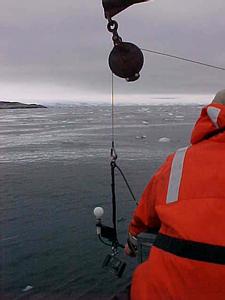
Avaliable light gatherer being lowered on the winch.
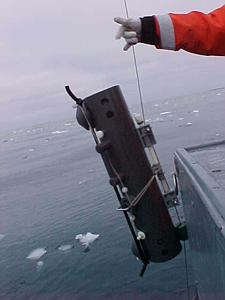
About to lower water sampling device on winch cable.

Kirk and Meg bringing full water sampler into boat.
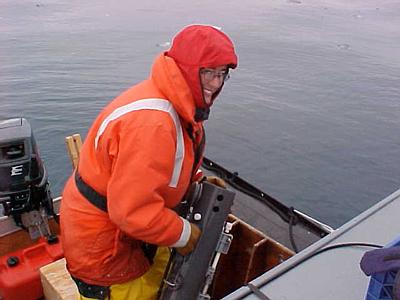
Placing full water samplers into their rack.

Low Rider coming to exchange passengers with Bruiser.
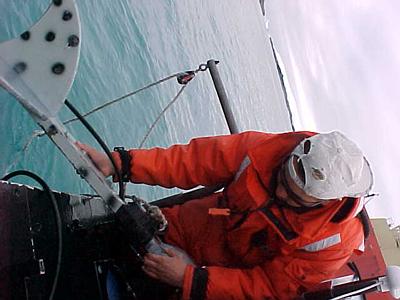
Andy bringing Kermit back on board after completing the last transect.
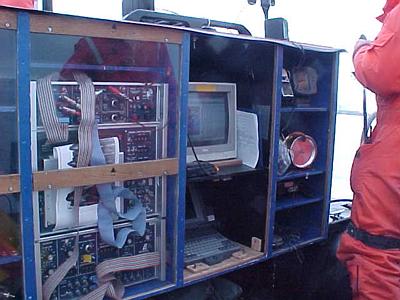
Low Riders instruments monitoring what is below the boat.

Contact the TEA in the field at
.
If you cannot connect through your browser, copy the
TEA's e-mail address in the "To:" line of
your favorite e-mail package.
|
